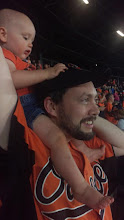This is the first of two cards that I received back in June (yep, I'm that far behind) from Butch, a distant relative by marriage who is himself a big sports fan and has the most amazing collection I've ever seen in person. He was generous enough to help me fill some holes in my Orioles inventory, and in the case of the card above, it serves a purpose for this blog as well!
This is my first two-player Rookie Stars card from this set, a format that Topps used from 1964 through 1971. Prior to this, they'd used a
four-player design, with players from multiple teams on one card. In 1972, they switched to
three players, all on the same team. A few teams still had
two per card, though.
As for the "star" designation, Topps was batting .500 on this card.
Curt Blefary would win the 1965 Rookie of the Year award in the American League while splitting time between the corner outfield sports in Baltimore. He beat out Angels pitcher (and future O's teammate) Marcelino Lopez for the honor by slugging 22 home runs, the first of three consecutive years of 20+ roundtrippers. Though he batted only .260, Curt's on-base percentage was a whopping .381 thanks to his 88 walks. He proved to be a patient and discerning hitter, finishing his eight-year career with more walks than strikeouts.
Though Blefary put together three solid years with the Birds, there were cracks in the foundation. After logging time in the outfield and at first base early in his career, Hank Bauer and Earl Weaver stuck him at catcher for 40 games in 1968. He was behind the plate for Tom Phoebus' no-hitter against the Red Sox, but he wasn't thrilled with his status as a defensive nomad. In a year dominated by pitchers, trying to learn a demanding new position certainly didn't help Curt. His .200 batting average was a career low, and his RBI total was half of what it had been the previous year (though he did log 100 less at-bats). It would prove to be his final year in Baltimore, as he was sent to Houston as the centerpiece of a deal that brought Mike Cuellar to Birdland. The trade was great for the O's, but not so much for Blefary. He spent one year as an Astro before being flipped to the Yankees for Joe Pepitone. Injuries and ineffectiveness soon hastened the end of the Brooklyn native's career; he didn't hit above .221 in his final three seasons (1970-1972), as he bounced from the Bronx to Oakland to San Diego.
After a long illness, Curt Blefary passed away at the age of 57 in January of 2001. His wife honored his wishes by having his ashes scattered on the site of Memorial Stadium in Baltimore. Though much of the old structure had been demolished by then, the Babe Ruth Museum supplied the home plate used during the 1991 farewell season at the park for a ceremony on May 24, 2001.
Fun fact: Former O's teammate Frank Robinson often made Blefary the butt of his jokes. It was Robby who coined the nickname "Clank" for Curt, based on the robotic futility of his defensive play. When the team bus drove past a landfill, Frank reportedly urged the driver to stop, "so Blefary can get a new glove". A few years later, when the Birds were steamrolling the competition in the A.L., then-Yankee Blefary told a reporter that "they're not Superman". Frank, Moe Drabowsky, and others conspired to greet their ex-teammate on the field prior to New York's next visit to Baltimore, at which time they unbuttoned their jerseys to reveal blue t-shirts with the Superman emblem on their chests.
As for
John Miller...he's not even the most well-known John (or
Jon) Miller in Orioles history. He was a hometown boy, at least. Miller got a few peeks at the big leagues before turning in a pretty good rookie campaign in 1965. In sixteen starts from late June through October, he went 6-4 with a 3.18 ERA. Unfortunately, he faltered the following season, posting a losing record (4-8) with a 4.74 ERA while splitting time between the bullpen and the rotation. After just two relief appearances in 1967, his contract was purchased by the Mets. For whatever reason, he never made it back to the majors. According to the Baseball-Reference Bullpen, he served as a firefighter after his baseball career ended.
Fun fact: Miller gave up only
twenty home runs in 227 innings in his career. However, seven of those longballs were hit by Washington Senators - that's over one-third of his total! The next-highest team total was three by the Indians.

